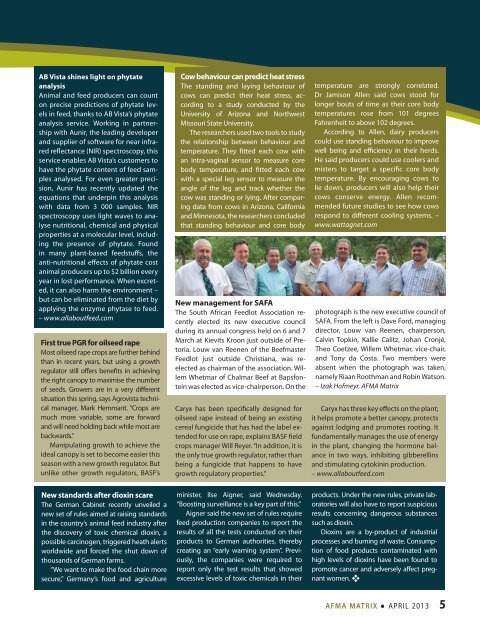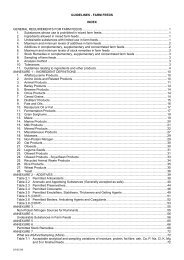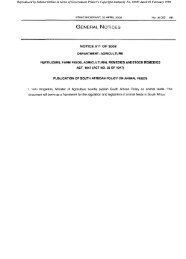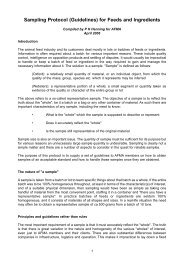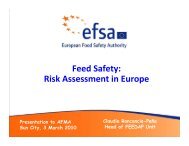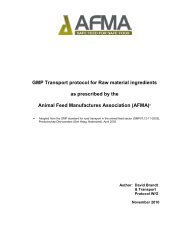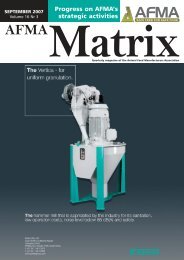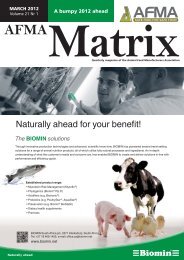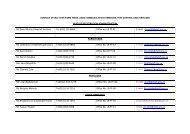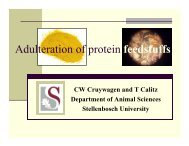Create successful ePaper yourself
Turn your PDF publications into a flip-book with our unique Google optimized e-Paper software.
AB Vista shines light on phytate<br />
analysis<br />
Animal and feed producers can count<br />
on precise predictions of phytate levels<br />
in feed, thanks to AB Vista’s phytate<br />
analysis service. Working in partnership<br />
with Aunir, the leading developer<br />
and supplier of software for near infrared<br />
reflectance (NIR) spectroscopy, this<br />
service enables AB Vista’s customers to<br />
have the phytate content of feed samples<br />
analysed. For even greater precision,<br />
Aunir has recently updated the<br />
equations that underpin this analysis<br />
with data from 3 000 samples. NIR<br />
spectroscopy uses light waves to analyse<br />
nutritional, chemical and physical<br />
properties at a molecular level, including<br />
the presence of phytate. Found<br />
in many plant-based feedstuffs, the<br />
anti-nutritional effects of phytate cost<br />
animal producers up to $2 billion every<br />
year in lost performance. When excreted,<br />
it can also harm the environment –<br />
but can be eliminated from the diet by<br />
applying the enzyme phytase to feed.<br />
– www.allaboutfeed.com<br />
First true PGR for oilseed rape<br />
Most oilseed rape crops are further behind<br />
than in recent years, but using a growth<br />
regulator still offers benefits in achieving<br />
the right canopy to maximise the number<br />
of seeds. Growers are in a very different<br />
situation this spring, says Agrovista technical<br />
manager, Mark Hemmant. “Crops are<br />
much more variable, some are forward<br />
and will need holding back while most are<br />
backwards.”<br />
Manipulating growth to achieve the<br />
ideal canopy is set to become easier this<br />
season with a new growth regulator. But<br />
unlike other growth regulators, BASF’s<br />
Cow behaviour can predict heat stress<br />
The standing and laying behaviour of<br />
cows can predict their heat stress, according<br />
to a study conducted by the<br />
University of Arizona and Northwest<br />
Missouri State University.<br />
The researchers used two tools to study<br />
the relationship between behaviour and<br />
temperature. They fitted each cow with<br />
an intra-vaginal sensor to measure core<br />
body temperature, and fitted each cow<br />
with a special leg sensor to measure the<br />
angle of the leg and track whether the<br />
cow was standing or lying. After comparing<br />
data from cows in Arizona, California<br />
and Minnesota, the researchers concluded<br />
that standing behaviour and core body<br />
New management for SAFA<br />
The South African Feedlot Association recently<br />
elected its new executive council<br />
during its annual congress held on 6 and 7<br />
March at Kievits Kroon just outside of Pretoria.<br />
Louw van Reenen of the Beefmaster<br />
Feedlot just outside Christiana, was reelected<br />
as chairman of the association. Willem<br />
Whetmar of Chalmar Beef at Bapsfontein<br />
was elected as vice-chairperson. On the<br />
Caryx has been specifically designed for<br />
oilseed rape instead of being an existing<br />
cereal fungicide that has had the label extended<br />
for use on rape, explains BASF field<br />
crops manager Will Reyer. “In addition, it is<br />
the only true growth regulator, rather than<br />
being a fungicide that happens to have<br />
growth regulatory properties.”<br />
temperature are strongly correlated.<br />
Dr Jamison Allen said cows stood for<br />
longer bouts of time as their core body<br />
temperatures rose from 101 degrees<br />
Fahrenheit to above 102 degrees.<br />
According to Allen, dairy producers<br />
could use standing behaviour to improve<br />
well being and efficiency in their herds.<br />
He said producers could use coolers and<br />
misters to target a specific core body<br />
temperature. By encouraging cows to<br />
lie down, producers will also help their<br />
cows conserve energy. Allen recommended<br />
future studies to see how cows<br />
respond to different cooling systems. –<br />
www.wattagnet.com<br />
photograph is the new executive council of<br />
SAFA. From the left is Dave Ford, managing<br />
director, Louw van Reenen, chairperson,<br />
Calvin Topkin, Kallie Calitz, Johan Cronjé,<br />
Theo Coetzee, Willem Whetmar, vice-chair,<br />
and Tony da Costa. Two members were<br />
absent when the photograph was taken,<br />
namely Riaan Roothman and Robin Watson.<br />
– Izak Hofmeyr, <strong>AFMA</strong> Matrix<br />
Caryx has three key effects on the plant;<br />
it helps promote a better canopy, protects<br />
against lodging and promotes rooting. It<br />
fundamentally manages the use of energy<br />
in the plant, changing the hormone balance<br />
in two ways, inhibiting gibberellins<br />
and stimulating cytokinin production.<br />
– www.allaboutfeed.com<br />
New standards after dioxin scare<br />
The German Cabinet recently unveiled a<br />
new set of rules aimed at raising standards<br />
in the country’s animal feed industry after<br />
the discovery of toxic chemical dioxin, a<br />
possible carcinogen, triggered heath alerts<br />
worldwide and forced the shut down of<br />
thousands of German farms.<br />
“We want to make the food chain more<br />
secure,” Germany’s food and agriculture<br />
minister, Ilse Aigner, said Wednesday.<br />
“Boosting surveillance is a key part of this.”<br />
Aigner said the new set of rules require<br />
feed production companies to report the<br />
results of all the tests conducted on their<br />
products to German authorities, thereby<br />
creating an “early warning system”. Previously,<br />
the companies were required to<br />
report only the test results that showed<br />
excessive levels of toxic chemicals in their<br />
products. Under the new rules, private laboratories<br />
will also have to report suspicious<br />
results concerning dangerous substances<br />
such as dioxin.<br />
Dioxins are a by-product of industrial<br />
processes and burning of waste. Consumption<br />
of food products contaminated with<br />
high levels of dioxins have been found to<br />
promote cancer and adversely affect pregnant<br />
women.<br />
<strong>AFMA</strong> MATRIX ● APRIL <strong>2013</strong> 5


